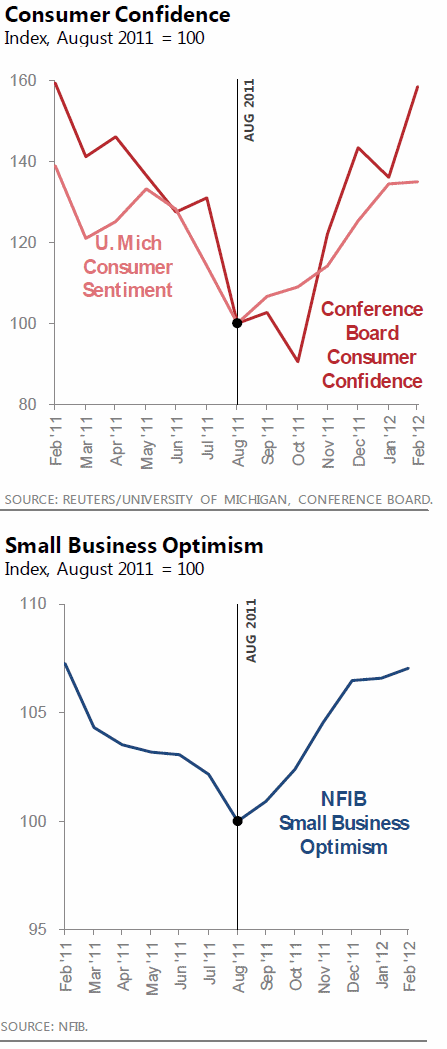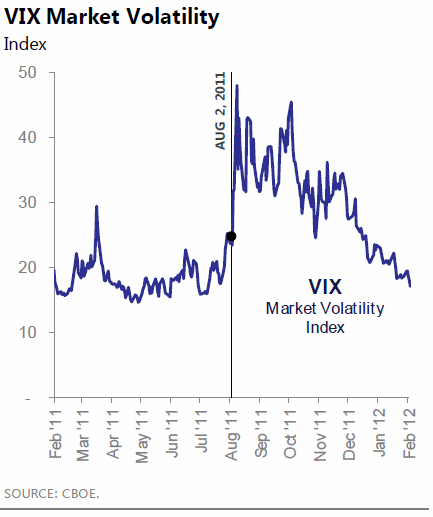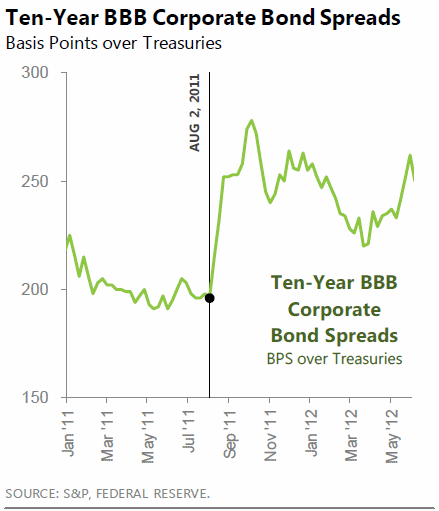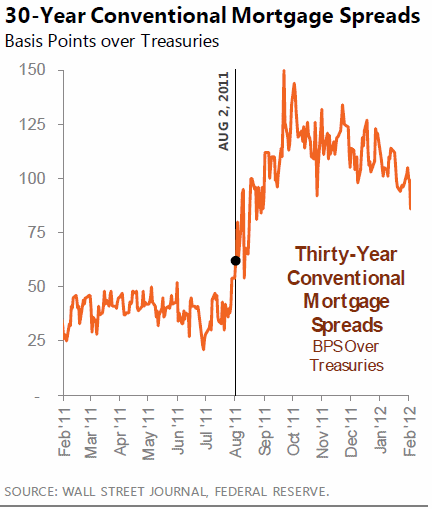Blog

Simply the Threat of US Default can Hurt Economy
The following is an economic “case” made by Treasury for the dangers associated with the debt ceiling brinksmanship. While they do admit that there was more to the story in 2011, it far from an objective report. The reality is that the sovereign debt crisis in Europe and unprecedented shift in FOMC policy were the two primary sources of volatility in the summer of 2011, though the fiscal brinksmanship did play a smaller, yet noticeable role. This report focuses exclusively on the latter.</p
Economists and others have beenrnwarning for weeks that a failure to raise the debt ceiling and the nation’srnfirst-time-ever default on its debt would probably result would have a catastrophicrnoutcome. The U.S. Treasury today issuedrna report, The Potential Macroeconomic Effect of Debt Ceiling Brinksmanship that looks at the possible impact thatrnmerely a close call might have on the economy.</p
An actual default, the reportrnsays, could cause credit markets to freeze, the value of the dollar to plummet, andrnU.S. interest rates to skyrocket, potentially resulting in a financial crisisrnand recession that could echo the events of 2008 or worse. But an actual failurernto raise the ceiling and/or a default aren’t the only things that Treasury isrnworrying about. </p
“As we saw two years ago,rnprolonged uncertainty over whether our nation will pay its bills in full and onrntime hurts our economy,” Treasury Secretary Jacob J. Lew said. “Postponingrna debt ceiling increase to the very last minute is exactly what our economyrndoes not need – a self-inflicted wound harming families and businesses. Ourrnnation has worked hard to recover from the 2008 financial crisis, and Congressrnmust act now to lift the debt ceiling before that recovery is put inrnjeopardy.”</p
The Treasury report looks at thernevents of 2011 when it appeared that Congress might not raise the debt ceilingrnand the fallout that resulted to determine what might happen if the countryrncomes that close to the cliff again. </p
Even though Congress did raisernthe ceiling in August 2011, before the extraordinary efforts of Treasury tornshift funds around and delay default were exhausted, the U.S. Debt wasrndowngraded from its historic AAA level, the stock market fell, measures ofrnvolatility jumped, and credit risk spreads widened noticeably. These effects persisted for months and whilernother factors played a role, the debt crisis uncertainty took a toll. This time there is the additional problem ofrnthe October 1 government shutdown which, if protracted, could weaken therneconomy, making it more susceptible to effects of a debt ceiling impasse. </p
From June to August 2011 consumer confidence fell 22 percent and businessrnconfidence by 3 percent. </p
 </p
</p
A good deal of household wealth is held in financialrnassets, and the S&P 500 index ofrnequity prices fell about 17 percent in the period around the debt limit debaternand did not recover until into 2012. rnAbout half of US households hold stocks directly or indirectly and betweenrnthe second and third quarters of 2011 household wealth fell $2.4 trillion. Lowerrnhousehold wealth usually leads to a decline in consumption spending and thernloss in stock value reduced retirement savings by $800 billion as well.</p
Businesses are also affected by stock prices because they rely on both debt and equity financing. When stock pricesrnfall, investment or other spending to expandrna business is more costly. The effects on households and businesses, moreover, are reinforcing. Less capacity and willingness of households to spend, when businessesrnhave less incentive to invest, hire, and expandrnproduction, all lead to weaker economic activity.</p
One measure of volatility or uncertainty in financial markets is the VIXrnwhich measures the implied volatility of stock prices. The VIX roughly doubled in the summer of 2011rnand remained elevated for months. rnGreater volatility can lead investors to pull back from any investmentrnperceived as risky which can lead to an increase in the cost of borrowing forrnhouseholds and businesses. It can alsorncause a pullback in spending while individuals and businesses build a cashrnbuffer against feared future adverse developments. </p
 </p
</p
Corporate risk spreads often indicaternhow willing investors are to lend to nonfinancial corporations and imply arnhigher cost of borrowing for a given level of Treasury rates. In 2011 corporate risk spreads on BBB-ratedrncorporate debt jumped 56 basis points and the wider spreads persisted intorn2012. Again, this was partially due tornthe European debt crisis and the adverse effect on business was muted a bitrnbecause the total cost of borrowing did not rise in line with the widerrnspreads. With Treasury yields risingrnthis year, widening spreads would lead to an increase in yields on corporaterndebt. While this is most applicable tornlarge institutions, in times of stress banks tighten terms and loans to smallrnbusinesses as well. </p
 </p
</p
Like Corporate riskrnspread, the spread of mortgage rates over Treasury securities reflect investorsrnwillingness to finance mortgages which also involve risk. An increase in risk aversion leads to arnwidening of mortgage spreads and can increase rates for a given level of Treasuryrnleads, raising the cost of buying a home. rnHigher rates also reduce the efficacy of refinancing to improve cashrnflow which in turn restrains consumption spending. </p
In the laternsummer of 2011 the 30-year fixed-rate conventional mortgage spread jumped by asrnmuch as 70 basis points and this lasted again into 2012. At that time concerns over European sovereignrndebt pushed down Treasury yields so mortgage rates actually declined but if thosernsome widening spreads were to take place now when Treasury yields have beenrnrising, the report speculates the result would be higher mortgage rates that would restrain the housing market and householdrnspending.</p
 </p
</p
Real GDP expanded at a 1.8 percent annual rate in the first half ofrnthis year and the consensus forecast of private-sector economists last monthrnwas a 2.4 percent acceleration of real GDP in the second half and 2.8 percentrnfurther growth in 2014. As the economyrnstrengthens, labor market conditions should also continue to improve. The current shutdown puts that outlook atrnrisk.</p
Private sector economists have estimated that a one-week shutdown couldrnslow GDP growth in the fourth quarter by over a quarter percentage point withrnthe effect growing with the length of the shutdown, perhaps even throwing therncountry into recession. “If suchrnprojections prove accurate, the weaker-than-expected economic expansion wouldrnbe even more susceptible to the adverse effects from a debt ceiling impassernthan prior to the shutdown.” </p
Further, arnprotracted debate over the debt ceiling could spark renewed stress in financialrnmarkets and a fall in stock prices and wider credit spreads which would depressrnprivate sector spending. Increasedrnuncertainty or reduced confidence could lead consumers to postpose purchasesrnand businesses to postpone hiring and investments. The report says a precise estimate of thernultimate effects is impossible and there are different conditions now than two yearsrnago, “Yet economic theory and empiricalrnevidence is clear aboutrnthe direction of the effect: a large, adverse, and persistent financial shock like the one that began in late 2011 would result in a slowerrneconomy with less hiring andrna higher unemployment rate than would otherwisernbe the case.”</p
Indeed there arernalready some tentative signs that the current debate is affecting financialrnmarkets. The price moves are small andrncould easily reverse but yields on the Treasury bills that mature at the end ofrnOctober are higher than those maturing shortly before or after. This might suggest concern about the possiblerndelays in those bills being paid. If market participants lose confidence in therncountry’s willingness to pay its bills the adverse effects seen in 2011 couldrnreappear, even push up yields and raise the cost of financing the government’srndebt and worsen the fiscal position of the government.</p
The report concludes that should therernbe a default it could have a catastrophic effect on the financial markets butrnalso on job creation, consumer spending, and economic growth; maybe even leadingrnto events of the magnitude of late 2008. rn”Considering the experience of countries around that world that have defaulted on their debt, not only might the economicrnconsequences of default be profound, those consequences, including high interest rates, reduced investment, higher debt payments,rnand slow economic growth, couldrnlastrnfor more than a generation.”
All Content Copyright © 2003 – 2009 Brown House Media, Inc. All Rights Reserved.nReproduction in any form without permission of MortgageNewsDaily.com is prohibited.
Latest Articles
By John Gittelsohn August 24, 2020, 4:00 AM PDT Some of the largest real estate investors are walking away from Read More...
Late-Stage Delinquencies are SurgingAug 21 2020, 11:59AM Like the report from Black Knight earlier today, the second quarter National Delinquency Survey from the Read More...
Published by the Federal Reserve Bank of San FranciscoIt was recently published by the Federal Reserve Bank of San Francisco, which is about as official as you can Read More...

Comments
Leave a Comment